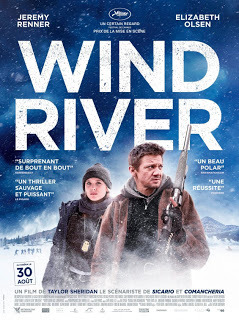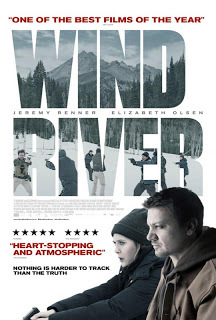WIND RIVER—NOTHING IS HARDER TO TRACK THAN THE TRUTH
 WIND RIVERNOTHING IS HARDER TO TRACK THAN THE TRUTH I’m not sure if I can express how much this film affected me on a level as deep and icy as the Wind River reservation it depicts. Directing from his own script, Taylor Sheridan—last year’s Best Screenplay Oscar winner for the riveting Hell Or High Water—turns Wind River into an unnerving slow burn punctuated by powerful jolts of violence. This mixture gains it’s emotional volatility from the inner core of the journey each character is following. Because of this, it all rings true, as the film’s violence is driven by the characters, not dictated by structured clichés, which demand a visceral kick for false and manipulative validation.
WIND RIVERNOTHING IS HARDER TO TRACK THAN THE TRUTH I’m not sure if I can express how much this film affected me on a level as deep and icy as the Wind River reservation it depicts. Directing from his own script, Taylor Sheridan—last year’s Best Screenplay Oscar winner for the riveting Hell Or High Water—turns Wind River into an unnerving slow burn punctuated by powerful jolts of violence. This mixture gains it’s emotional volatility from the inner core of the journey each character is following. Because of this, it all rings true, as the film’s violence is driven by the characters, not dictated by structured clichés, which demand a visceral kick for false and manipulative validation.The story in Wind River is disarmingly straightforward. Grizzled U.S. Fish and Wildlife agent Cory Lambert is forced to confront his past when he agrees to collaborate with rookie FBI agent, Jane Banner, to solve the harrowing circumstances behind the murder of a young woman on the Wind River Indian Reservation in Wyoming. Expectations raised by these circumstances are negligible—we’ve seen this all before. But in Wind River, the surface murder mystery, and it’s relatively mundane solution, are a smoke and mirrors distraction to allow the true underlying plot to slowly surface like a blade of spring grass piercing hard—packed snow.
 Wind River spins its simple premise on its head, chipping away at what we think we know, to reveal a haunting, metaphor about fatherhood, male bonding, race, poverty, isolation, surviving the unsurvivable, and determination. The final effect comes full circle when a sentence appears on the screen, seconds before fade out, carrying an emotional punch far more visceral than all the prior scenes of violence.
Wind River spins its simple premise on its head, chipping away at what we think we know, to reveal a haunting, metaphor about fatherhood, male bonding, race, poverty, isolation, surviving the unsurvivable, and determination. The final effect comes full circle when a sentence appears on the screen, seconds before fade out, carrying an emotional punch far more visceral than all the prior scenes of violence.Jeremy Renner is terrific as Fish And Wildlife officer, Cory Lambert. He is the keystone of the film, his face and demeanor displaying a constant emotional, internal, concentration. He is never out of step with the elements of either story or the harsh setting. He is always the relentless hunter of predators—in all their forms—who target the weak. There is never a moment where it is unclear what his motivations are or why he takes the actions he intuitively understands are required.
 Renner is well matched by Elizabeth Olson as Jane Banner. Her diminutive stature should have been a casting fail, but she doggedly follows the lead of Emily Blunt, an actress who has honed overcoming her physical size into an art form. Portraying an FBI agent dropped into an alien world, Olson also benefits from a script which doesn’t treat her character with distain. Jane Banner is well aware she is out of her element, but sharp enough, and tough enough, to make the necessary adjustments to her situation without hesitation or consternation.
Renner is well matched by Elizabeth Olson as Jane Banner. Her diminutive stature should have been a casting fail, but she doggedly follows the lead of Emily Blunt, an actress who has honed overcoming her physical size into an art form. Portraying an FBI agent dropped into an alien world, Olson also benefits from a script which doesn’t treat her character with distain. Jane Banner is well aware she is out of her element, but sharp enough, and tough enough, to make the necessary adjustments to her situation without hesitation or consternation.With help from the Tribal Police Chief—another character given a solid anchoring in reality—determining who sent young Natalie running barefoot through the snow to an icy grave, puts Lambert and Banner on a path to truths as chilly and as barren as the desolate environment surrounding them.
As the director, Sheridan stages his climax magnificently. Smoothly blending in a key flashback at exactly the right moment, he reveals the chilling extent of what Natalie endured before she escaped into the frozen wasteland, a warrior alone and without hope. What follows is a bravura sequence, the intensity almost too much to take after the deliberate pacing of what has gone before.
As with Hell Or High Water, Sheridan ends his story not with violence. Instead, he captures us with an emotional elasticity, which goes way beyond the solving of a murder mystery or the catching of a killer. The impact of the raw emotion, which leaves you sitting in your seat until the final credit rolls, comes not from the physical violence, but from the agonizing sincerity of the characters—a dynamic cutting across the fences of race, gender, and societal class as if they were non-existent.
Published on September 24, 2017 11:24
No comments have been added yet.



